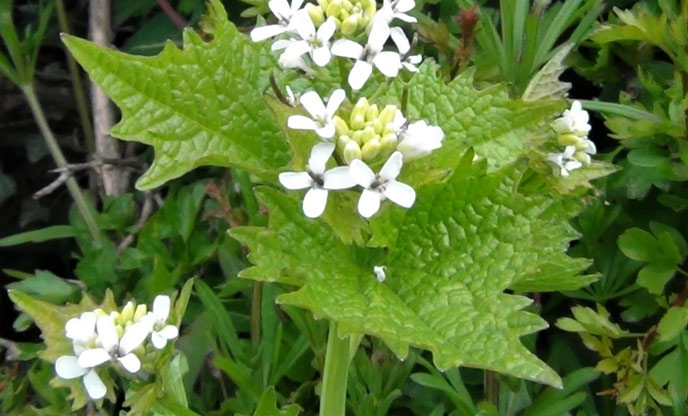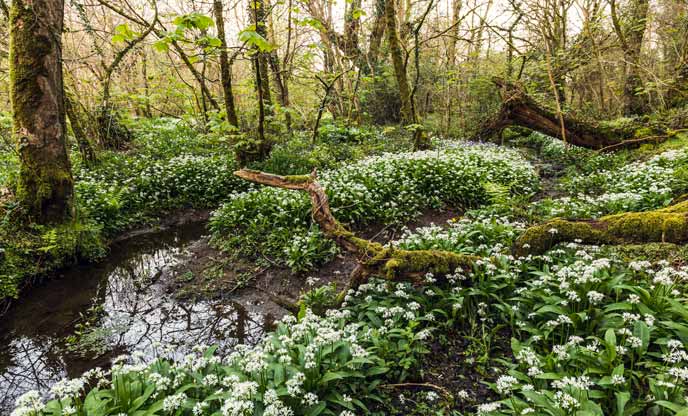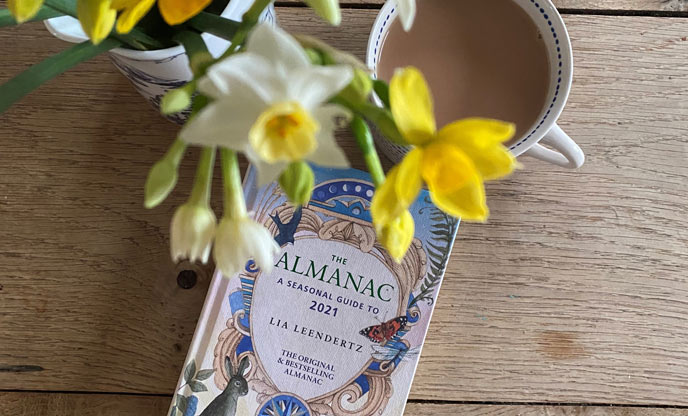Spring foraging guide
Penned on the 20th March 2023

To mark the spring equinox, we're turning our awareness to nature's fruits. A thread of days with equal dark and light that mark the return of colour and liveliness to the sleepy landscape of winter. Dainty emerald shoots begin to forge their way above ground having bided their time during the long cold months. Wildlife and nature stretch out their limbs after a winter of slumber as the sun climbs higher and casts its warm glow across the land.
The spring equinox has long been known as a time of renewal, rebirth, and new beginnings, and is celebrated by many cultures across the Northern Hemisphere through various rituals and customs. It is a time for commemorating the vibrant return of spring and realigning with the rhythms of the natural world after hibernating indoors during winter. It can also be seen as an opportunity to reconnect with ourselves, checking in on new year resolutions and cultivating a renewed sense of forward momentum as we move into the warmer months.
As we emerge from the darkest days of the year and steadily tread towards the light, the spring equinox is the perfect time to bask in Nature’s renewal and shed any residual winter blues through a foraging adventure. You can try your hand at foraging all year round, we also have a summer foraging, autumn foraging and winter foraging guide. And if you fancy experiencing foraging with a professional guide, read all about our spring foraging adventure with 7th Rise.
Here, have collated a list of wild edibles to bring the flavours of spring from sunlit woodland passages and coastal paths straight to your table, alongside an equinox ritual to connect you to nature as it sets its feet on a new path for the upcoming year.
Nettle (Urtica dioica)
When we think of nettle, many of us probably picture days wandering barefoot in summer, returning home with constellations of itchy red pinpricks on our ankles and shins. However, nettle has been used in traditional medicine and culinary practices for centuries. Rich in vitamins and minerals like Vitamin A, C, and Iron, as well as having potent anti-inflammatory benefits, it seems somewhat miraculous that a humble garden plant we know so well - and mostly avoid - can do us so much good.
Nettle comes into season in March and is harvestable until November. When foraging nettle, it’s best to avoid older leaves, including those that appear after flowering, as they contain cystoliths - small particles that can irritate the kidneys. Try to harvest younger leaves instead.
One of the easiest ways to consume nettle is by brewing it into herbal tea. When boiled, the leaves lose their irritating effect, and adding a little honey into the mixture makes for a calming, healthful drink.
Tips for harvesting and brewing nettle:
● Wear thick garden gloves; the hairs on the fresh leaves are highly irritating to the skin
● Find a patch of nettle that's top leaves are ideally knee-high, especially in areas with a lot of footfall, and avoid harvesting the lower levels of the plant
● Use scissors or garden shears to remove the top layer of leaves from the plant, leaving the lower half of the plant still rooted so it can continue to grow and flower
● Soak the leaves in a bowl of water before rinsing thoroughly
● Add the leaves into a pot of cold water on the stove and bring to the boil
● Turn off the heat and allow the nettle to stew in the water for 5 minutes (the longer you leave it, the stronger and more bitter the tea will taste)
● Pour the mixture through a strainer
● Add honey, lemon, or cinnamon to taste
Dandelion (Taraxacum officinale)

With its sunny mane of yellow petals, the Dandelion is best known as a weed. What is less known, however, is the whole plant is both edible and medicinal - even the roots! It flowers in late spring, with leaves ready for harvest by the end of February. Best known for its diuretic properties, it is used in traditional herbal medicine to treat UTIs and support liver and kidney function.
Dandelion is an incredibly versatile plant. Its leaves have an earthy flavour and can be used similarly to spinach in savoury dishes, such as this sautéed dandelion and eggs recipe, or to make a herbal tea when harvested young. The flowers are sweet to taste, making a beautiful garnish for spring dishes; they can even be used to craft a dandelion salve to soothe wind-kissed skin.
As it is considered a pest found in most grassy areas, it’s best to harvest dandelions from your own garden, or an area that you know will be untouched by pesticides.
Hawthorn (Crataegus monogyna)

Adorned with thorny branches and found widely across the UK, the hawthorn tree is one of the first to awaken after winter and is considered a superfood by many herbalists due to its beneficial effects on the cardiovascular system. Although it is of the tree family, hawthorn can appear as more of a hedge growth, growing densely in woodland and farmland.
Its bright red berries don’t ripen until September, but the young leaves that appear in March and April have a delicious nutty flavour and make a brilliant addition to salads
Garlic Mustard (Alliaria petiolata)

Garlic mustard - also known as hedge garlic and jack-by-the-hedge - is a wonderful option for novice foragers as it is both easy to identify and use. It comes into season in early spring and is a member of the mustard family which includes other vegetables such as cauliflower, broccoli, and cabbage. Favouring moist, partly shaded areas it can be found in abundance in woodland, hedgerows and even wasteland.
Much like wild garlic, the leaves and flowers of garlic mustard are edible and can be used in fresh salads, to garnish dishes, or even as a pesto alternative. Additionally, the stem of the plant is edible, offering a peppery-garlic flavour when used in dishes such as this garlic mustard and blue cheese pasta.
Wild Garlic (Allium ursinum)

Celebrated for its antioxidant, antibacterial and antifungal health benefits, wild garlic is another ideal plant to experiment with when you’re new to foraging. Easily identified by its unmistakable scent (you guessed it - garlic!) it grows abundantly in woodland areas all over the UK. The vibrant green leaves, best picked when young, are a wonderful addition to soups, and make a delicious pesto. When flowering, the plant is decorated with delicate white flowers which are also edible and can be used as a garnish on many dishes from salads to risottos.
Seasonal Eating

This time of year is when fruits and veggies such as apples, carrots, leeks, mushrooms, celeriac, squash, and white cabbage are in season. Recipes and guidance can be easily accessed online, or through books such as The Almanac. Why not try this warming recipe by Anna’s Family Kitchen, incorporating easily-sourced seasonal ingredients with some foraged wild garlic to get started?
Wildflowers and Rituals for New Beginnings

Of course, edible plants and herbs aren’t the only gifts we can borrow from nature at this time of year. The beginning of spring offers a vibrant palette of newly blooming wild and garden flowers, such as daffodils, hyacinths, snowdrops, bluebells and crocuses, that can brighten up home spaces. There are many useful books that help with identifying wildflowers, such as Wild Flowers of Britain: Month by Month, by botanist and water-colourist, Margaret Wilson.
Creating an altar in a chosen area of your home is another use for collected flowers, and can be incorporated as part of an intention-setting ritual to honour the spring equinox. Intention-setting rituals involve creating a mindful space to sit and reflect on your journey so far whilst contemplating intentions you’d like to carry forward.

Start by selecting a small undisturbed corner of your home to set up your altar. Gather foliage, flowers, and other spring-orientated adornments, such as decorated eggs (a symbol of rebirth), and arrange them in the area. Floral and herbal scents associated with spring are another nice addition to spring altars and can be added through the use of scented candles or essential oils. You can also include items such as crystals or personal talismans that are meaningful to you to personalise your altar.
Once you have arranged your altar, light a candle in the centre to symbolise the returning light of spring. Then sit down with a journal, pen, and perhaps a cup of freshly foraged nettle tea to reflect on your feelings from the winter, and all the wonderful things you’d like to cultivate in the months to come.
* Disclaimer: When foraging wild food you must be able to 100% positively identify what you are harvesting. Do not eat any plants, berries, mushrooms, or herbs you are uncertain of, as some may be poisonous. Use multiple methods of identification - such as Google, plant identification apps, or books. Wash produce thoroughly before consumption. Consult your doctor if you are taking medication before consuming certain herbs as interaction may occur. Always be respectful to nature, and try not to disturb surrounding wildlife. Do not take more than you need, leaving enough of the plant in place to regrow, and ensure you have permission to harvest from the area. Happy foraging! *
